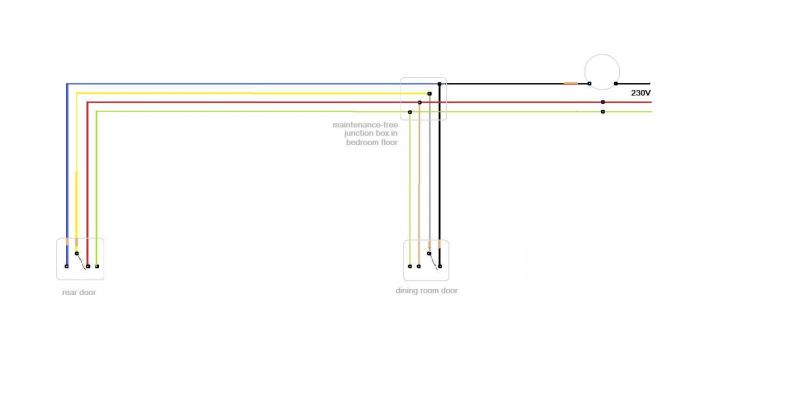Trying to do some two-way switching. Looks like it might be a bit of a pita to pull more than a 3c&e in to each switch, so was wondering. What's the best way to wire it? Looks like it's a five terminal JB job? Is there a JB that can accommodate that? Will the terminals all fit in a Wago? I seem to recall the previous owner did something similar with a four-terminal, with the CPCs twisted together and tucked behind the JB. Obviously one can't do such a thing these days, with it not being accessible for inspection of the twists.
You are using an out of date browser. It may not display this or other websites correctly.
You should upgrade or use an alternative browser.
You should upgrade or use an alternative browser.
Two way lighting
- Thread starter ekmdgrf
- Start date
Sponsored Links
You only need a 4 terminal box - Ashley/ Hager J804.
I seem to recall the previous owner did something similar with a four-terminal, with the CPCs twisted together and tucked behind the JB. Obviously one can't do such a thing these days, with it not being accessible for inspection of the twists.
The issue is not one of access. All conductors must be inside the enclosure. The outer sheath of the cables must be enclosed by the terminal box itself.
Also, remember these boxes do not have any cable strain relief clamps, so the box must be screwed to backgrounds, and the cables clipped to prevent them being yanked out.
or follow EFLI's advice.
Sponsored Links
The electrical installation I inherited, many moons ago (mainly of early/mid 80s vintage), made extensive use of 'external connection' of the CPCs. However, the JBs were (mainly!) screwed down, the cables clipped, the outer sheaths of cables entirely contained within the JB and the CPCs sleeved in G/Y (or was it green?!). Those (sleeved) CPCs then did a 'U-turn' within the JB, exited the JB through the same hole as their cable, and were all joined with some sort of connector block screwed down (usually) close to the JB.The issue is not one of access. All conductors must be inside the enclosure. The outer sheath of the cables must be enclosed by the terminal box itself. ... Also, remember these boxes do not have any cable strain relief clamps, so the box must be screwed to backgrounds, and the cables clipped to prevent them being yanked out.I seem to recall the previous owner did something similar with a four-terminal, with the CPCs twisted together and tucked behind the JB. Obviously one can't do such a thing these days, with it not being accessible for inspection of the twists.
I got rid of all (I hope - certainly most!) of that a long time ago - but, whilst it was not particularly beautiful, I'm not sure that I can see any reason why such an arrangement would (if accessible) not be compliant even today - can you?
Kind Regards, John
I seem to recall the previous owner did something similar with a four-terminal, with the CPCs twisted together and tucked behind the JB. Obviously one can't do such a thing these days, with it not being accessible for inspection of the twists.
The issue is not one of access. All conductors must be inside the enclosure. The outer sheath of the cables must be enclosed by the terminal box itself.
Also, remember these boxes do not have any cable strain relief clamps, so the box must be screwed to backgrounds, and the cables clipped to prevent them being yanked out.
or follow EFLI's advice.
So assuming strain relief is in place and the conductors are enclosed within the enclosure, one can just wrap then around each other and rely on Newton's first law to maintain continuity?
Certainly not that, no - but if you did it in the manner I described above (as I found in my house), as I said, I can't yet think why that would not be compliant today. You would certainly need to join the CPCs with a connector block or suchlike, and not rely on twisting and Mr Newton!So assuming strain relief is in place and the conductors are enclosed within the enclosure, one can just wrap then around each other and rely on Newton's first law to maintain continuity?
Kind Regards, John
The fixing holes were also a way to bring out the cpcs for external twist.
With the 'dangling' ones, yes - I've seen plenty of that - but the fixing holes cease to become available for that purpose if there are screws in themThe fixing holes were also a way to bring out the cpcs for external twist.
Kind Regards, John
With the 'dangling' ones, yes - I've seen plenty of that - but the fixing holes cease to become available for that purpose if there are screws in themThe fixing holes were also a way to bring out the cpcs for external twist.
Kind Regards, John
You could screw it in lightly, and wrap a piece of wire around all four screw, then each CPC could be spot welded to the head of one of the screws.
DIYnot Local
Staff member
If you need to find a tradesperson to get your job done, please try our local search below, or if you are doing it yourself you can find suppliers local to you.
Select the supplier or trade you require, enter your location to begin your search.
Please select a service and enter a location to continue...
Are you a trade or supplier? You can create your listing free at DIYnot Local
Sponsored Links
Similar threads
- Replies
- 17
- Views
- 4K


